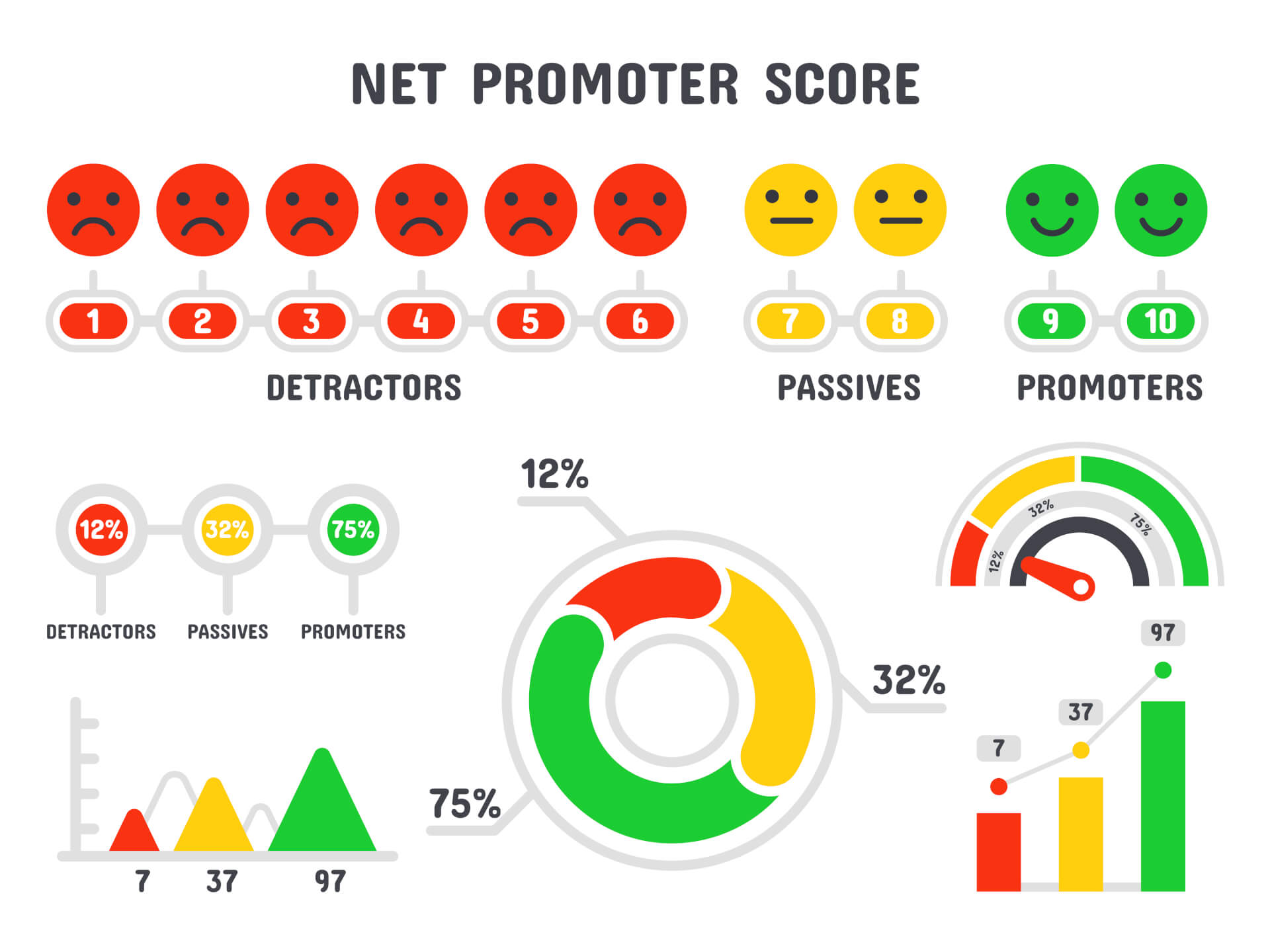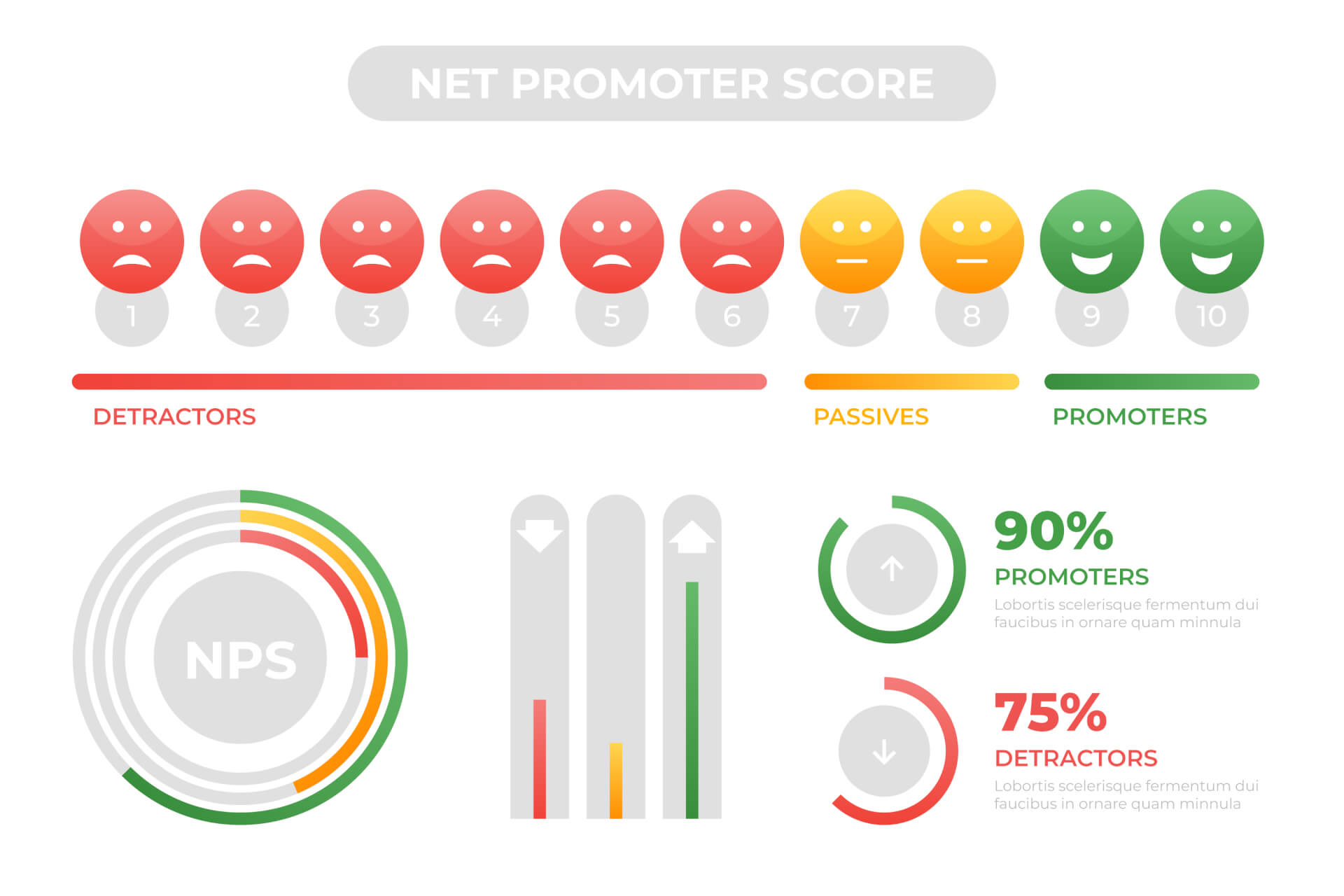 Putting things in numbers is a popular way of making and categorizing measurements.
Putting things in numbers is a popular way of making and categorizing measurements.
By assigning simple numerical values to abstract concepts, one gets the feeling that they can be better understood and controlled. Higher scores are automatically associated with better quality, a bias marketers like to capitalize on when it comes to the next, better, bigger, and heavier version of a product.
Numerical values, when used and analyzed correctly, can be invaluable to any business.
With a Net Promoter Score survey, you receive a variety of values that provide the status of your company, a product, or the quality of your support team.
The NPS survey also shows you which of your customers are satisfied with your service, who is an enthusiastic supporter of your brand, and who did not like your services.
But how do you use these values? What actions are you taking with each customer?
The Net Promoter Score is an indicator of customer loyalty
 Since its introduction in 2003, the NPS has been used to evaluate customer satisfaction. It's an excellent way to measure your relationship with customers.
Since its introduction in 2003, the NPS has been used to evaluate customer satisfaction. It's an excellent way to measure your relationship with customers.
An outside perspective works wonders and can point you to many things you might otherwise miss.
The score can range from -100 (nobody likes your product) to 100 (everyone loves it). While the score itself says a lot, NPS surveys are less about the value achieved and more about increasing the previously measured value.
This is where customer feedback is collected, whether it's good or bad. Depending on the number of points given, these customers are divided into three main groups:
- Promoters
Customers who rated 9 and 10 points - Passives
Customers who rated 7 and 8 points - Critics
Customers who rated 6 or less
Critics
 are the customers who give a low score in the review.
are the customers who give a low score in the review.
This is usually caused by a bug or problem they encountered, unsatisfactory communication with support, or features that don't meet their needs at all.
A large part is therefore frustrated that the use of your product or service did not work out as they initially imagined.
When contacting critics, first review any previous contacts you've had with them:
Conversations, tickets and other touchpoints should be examined in advance so that the employee can get an idea of whether something has happened, whether it is an application error, or your service did not match what the customer was looking for.
This is where it can be helpful to have your customer support team contact these critics, as they can better understand the errors and offer a solution face-to-face.
You won't change the minds of every critic, but you'll bring those back on board for whom you can solve the problem directly. You will also receive important information about what these customers expect from your product.
Passives
 are the customers who give a rating in the middle. These customers are relatively happy with your business, but aren't thrilled yet.
are the customers who give a rating in the middle. These customers are relatively happy with your business, but aren't thrilled yet.
This group is one of the customers you can probably easily contact for further interviews.
Passives won't tell you that your business is great, but neither will these customers be dazzled by some recent annoyances like detractors can be.
Talk to these customers about your product, its features, what they particularly like about it, what other parts they think are unnecessary or bad, and what makes them particularly comfortable.
These customers appreciate your product, but lack that little trigger that would make them love it. Focus on this group and act directly on the feedback you receive, and show the customer that you value the feedback. This is usually the necessary push to turn this customer into a promoter.
If you neglect this group of customers, they will soon become critics and eventually leave.
Promoters
 are the customers who love your company - your fans.
are the customers who love your company - your fans.
You also need to contact this group of customers to find out what makes your product/brand so valuable to them.
With promoters, you want to go into as much detail as possible. Ask about the motives when choosing the products, what challenges they want to overcome with them and what the main difference between you and your direct competitor is.
These customers already fully support your company. Therefore, contact this customer group to ask for a customer review, a case study or a rating on an external rating portal.
Keep the fire burning and reward these customers with things like gift certificates or a discount on their next purchase.
Even if you can't offer them a reward, don't worry - you may be surprised at how many of these customers tend to leave a review.
Size matters, but it's still just a number
Don't obsess over NPS score value - focus on digging deep with NPS and reaching as many people as possible so you can get as much useful feedback as possible.
It is therefore important to formulate the questions correctly. This allows you to focus on the issues, bugs, and actual changes and improvements your customers want you to make.
At the end of the day, what counts is not the score achieved, but the complaints, useful criticisms and suggestions that you have collected and identified and can implement directly to remove obstacles and continue to improve your products and services.
Getting started with NPS customer surveys is easy
Start using NPS today as a tool to measure customer satisfaction and improve your business. With our permanently free-of-charge Callexa tariff "Free" you can already survey 50 recipients per month.
 Reading recommendation: If this article helped you and you would like to find out more about the Net Promoter Score, continue reading here: “The Net Promoter Score – Basics and Areas of Application”
Reading recommendation: If this article helped you and you would like to find out more about the Net Promoter Score, continue reading here: “The Net Promoter Score – Basics and Areas of Application”